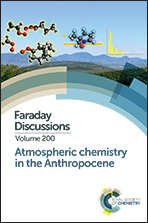Introductory lecture: atmospheric chemistry in the Anthropocene
Abstract
The term “Anthropocene” was coined by Professor Paul Crutzen in 2000 to describe an unprecedented era in which anthropogenic activities are impacting planet Earth on a global scale. Greatly increased emissions into the atmosphere, reflecting the advent of the Industrial Revolution, have caused significant changes in both the lower and upper atmosphere. Atmospheric reactions of the anthropogenic emissions and of those with biogenic compounds have significant impacts on human health, visibility, climate and weather. Two activities that have had particularly large impacts on the troposphere are fossil fuel combustion and agriculture, both associated with a burgeoning population. Emissions are also changing due to alterations in land use. This paper describes some of the tropospheric chemistry associated with the Anthropocene, with emphasis on areas having large uncertainties. These include heterogeneous chemistry such as those of oxides of nitrogen and the neonicotinoid pesticides, reactions at liquid interfaces, organic oxidations and particle formation, the role of sulfur compounds in the Anthropocene and biogenic–anthropogenic interactions. A clear and quantitative understanding of the connections between emissions, reactions, deposition and atmospheric composition is central to developing appropriate cost-effective strategies for minimizing the impacts of anthropogenic activities. The evolving nature of emissions in the Anthropocene places atmospheric chemistry at the fulcrum of determining human health and welfare in the future.
- This article is part of the themed collections: The Spiers Memorial Lectures and Atmospheric chemistry in the Anthropocene


 Please wait while we load your content...
Please wait while we load your content...